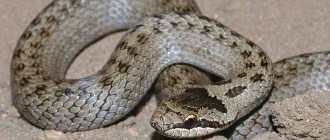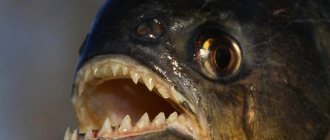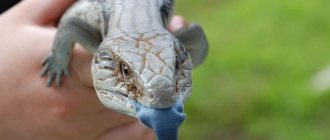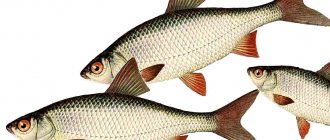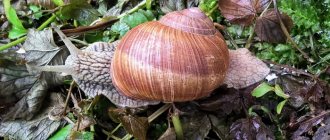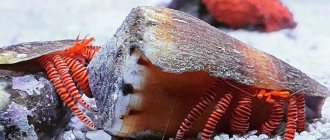The blue-tongued skink (lat. Tiliqua scincoides) or the common giant lizard is one of the subspecies, but all the things described below are suitable for all other types of skinks, including the giant one (lat. Tiliqua gigas). These are ideal lizards for beginners, as they have a lot of charm and an interesting appearance, but they will also interest advanced ones; breeding is not such an easy task, and some subspecies are also extremely rare.
Description of the family
The skink family (Latin name Scincidae) are lizards, of which there are up to 1.5 thousand species in nature. A characteristic external feature of the family is smooth scales, visually reminiscent of fish. Skinks' eyes have a round pupil and separate movable eyelids, and the lower one has a fold that allows them to see the surrounding space with “closed eyes.”
They eat a wide variety of foods, are mainly predators, but also consume plants. They reproduce using eggs or viviparity.
The blue-tongued skink (tiliqua - from the Latin Tiliqua scincoides) is a fairly large lizard with a smooth body and a thick tail; in nature there are several species of such skinks. They got their name for the bright blue-violet color of their long tongue, which when protruded can reach a size twice the size of the head. This language is created by nature to frighten birds of prey and other animals that want to hunt the skink.
Interesting Facts
- Since scientists could not decide on the color of the tongue, an ancient legend filled the gap of information. Once upon a time, a domestic skink sought to help its sick owner and carried a bottle of medicinal ink in his mouth. He was in such a hurry that the liquid splashed and turned his tongue blue.
- Interestingly, the tongue of a skink protruding from its mouth is twice as long as the size of its head.
- What distinguishes the skink from other reptiles is its habit of thoroughly chewing food, moving it around in the mouth using the tongue. Other reptiles simply swallow their food.
The Tiliqua genus and their history
Such lizards were first described and brought to Europe at the end of the 18th century from the eastern part of Indonesia. Already by the second half of the 19th century. skinks were exhibited in large numbers in zoos in Australia and Europe and were successfully bred at home. Due to their phlegmatic nature and unpretentiousness, they have become one of the most common animals that can be kept in a terrarium.
Tiliquas include several species that differ in color and the name of the area in which they live in nature. Thus, according to their habitat, there are 7 species: common, giant, dwarf, short-tailed, black-tempered and black-and-yellow.
Description of the blue tongue skink:
- the size of the lizard can exceed 60 cm, but more often 45-50 cm;
- the tail is quite thick and short;
- the color of the body can be different: gray, black, yellow-orange, with stripes or spots, depending on the species and habitat;
- each limb has 5 fingers with claws;
- the head is triangular gray, located on a short neck;
- the jaws are equipped with flat teeth, and a blue tongue hangs from the mouth.
Since 1972, Australia and New Guinea have introduced laws prohibiting the export of reptiles from these countries.
Natural enemies
In the wild, skinks are hunted by:
- dogs/cats (domestic and stray);
- wild dogs dingoes;
- large snakes;
- gray monitor lizard;
- birds of prey (for example, the laughing kookaburra and brown falcon).
When in danger, reptiles behave differently . Some, like the blue-tongued skink, take the usual defensive pose, hissing and puffing up. At the same time, the lizard opens its mouth wide, scaring off the enemy with a blue tongue, which sharply contrasts with the bright red oral cavity.
This is interesting! A desert skink, a desert skink, goes deep into the sand to emerge at a safe distance from the enemy.
Among the skinks, there are also those who are prone to catalepsy: when frightened, they become numb, as if dead.
Return to content
Habitat
The habitat of skinks (another name is “common gigantic lizard”) is the continent of Australia, as well as the islands of Tasmania, Indonesia (east), New Guinea and some small Pacific islands. On the map, the range resembles a crescent, starting in the south of the northern part of the continent, passing through the western region and ending in southern Australia.
All types of tiliquas are very unpretentious and are distributed in numerous regions with different climatic conditions. These are mountain forests, deserts and semi-deserts, ocean coasts, etc. In urban areas they settle in parks and gardens.
Their peak activity occurs during the day, but they do not like extreme heat, sitting out during these hours in animal burrows, cracks or empty tree trunks.
Natural enemies of tiliqua: large birds, dingoes, monitor lizards. When threatened, skinks take a defensive position, bending their body, opening their mouth completely and sticking out a large blue tongue, while emitting a threatening hiss, and can bite.
Skinks have good eyesight, but see everything in black and white. In nature, they feed on insects and plant foods and do not disdain carrion. They are viviparous animals; offspring appear in nature once a year, 10-20 cubs.
They shed periodically, rubbing against hard surfaces of stones and branches. The average life expectancy is about 20 years.
Mr. Tail recommends: varieties
The skink lizard is currently divided into four subfamilies, but scientists believe that this classification will be changed in the coming years:
- Akontieva (Acontinae);
- Ligosomal (Lygosominae);
- Scincinae;
- Blind (Feylininae).
Here are just a few of the most famous and interesting species for exotic lovers. It is believed that blue-tongued, crocodile, and common skinks are more suitable for home keeping, but other varieties are increasingly found in terrariums. All these reptiles delight owners with their obedience, exemplary behavior and ability to quickly tame.
Common Skinks
Pharmacy skinks (Scincus scincus) got their name because in ancient times, the ashes after burning the bodies of lizards were used as a remedy and an aphrodisiac in Arab countries, and in Ancient Egypt, embalmed reptile mummy was buried along with the dead.
The maximum body length of the animal, which lives mostly in the Sahara, other countries of Africa and South-West Asia, is about 20 cm. This Skink is also called sand fish, since the lizard is capable of moving in the desert at speeds of up to 15-20 km/h. The video footage shows that the movements of the reptile resemble swimming, and the sand flows off the smooth scales without scratching them.
Scientists suggest that the micro-protrusions on the lizard's scales have an electrical charge, which are repelled by grains of sand (they are negatively charged).
Short-tailed Skinks
Trachydosaurus or Trachysaurus is a species of skink that also belongs to the genus Tiliqua. This is a variety of the Blue-tongued Australian Skink.
The species was described back in 1825 by the English scientist John Edward Gray. A strong and heavy body with an acute-angled head of brown tones (from light to dark), and its maximum length is 36 cm. They live in the steppes and semi-deserts of Australia. Omnivorous. Natural enemies of short-tailed animals are Dingo dogs and Australian pythons, foxes and cats. Aboriginal people still eat lizard meat today.
The tongue is also blue, but this reptile cannot cast its tail due to its anatomical features; for it it is only a storage of fat reserves.
Giant or Australian Blue Tongue Skinks
Tiliqua scincoides is a large lizard, some representatives reach a length of 60-70 cm. The body is large and strong, of various, often inconspicuous colors, the tail is slightly more than half the length of the body. The paws are short, with five toes. The giant's homeland is deserts, semi-deserts, steppes, savannas, rainforests of Australia, New Guinea, and the islands of Oceania. This species has many subspecies with different biotypes.
They are omnivores, but prefer plant foods. They lead a diurnal lifestyle, but in the hottest times they try to find shelter in holes, cracks, and tree trunks. This is a territorial species, actively protecting its habitat, although in other cases it is peaceful.
In appearance, gender differences are not visible. They can be identified only by the behavior of individuals during the mating season - the male holds the female by the neck with his teeth during mating (September-November).
The subspecies most often kept in captivity has a dark brown body background with bright orange patterns. The oral cavity is deep red, and the color of the tongue is deep blue to purple. Life expectancy is up to 20 years.
These pets are smart, recognize the owner, recognize their nickname and some commands. They are very affectionate and love to be held and petted. You can even walk outside with these Skinks. They behave calmly in the house, sleep at night and do not bother anyone. For keeping, it is better to choose lizards of different sexes or one lizard, since two males can quarrel over territory.
Crocodile skinks
The body dimensions of this lizard are small - 17-19 cm. But the head is disproportionately large in relation to the body, which makes it look like a miniature dinosaur or dragon. A ridge of four rows of bone plates with needles runs along the ridge. The upper part of the body is brownish in color, and the abdomen is much lighter. The bulging large eyes are surrounded by orange rings, which gives the variety its name. This color is characteristic of crocodiles.
The lizard's homeland is the islands of Papua New Guinea. They settle near bodies of water in tropical rainforests and coconut groves. They swim well, so it is necessary to provide a small pond in the terrarium. These mini-crocodiles do not tolerate temperatures above +30 ° C, they are in a hurry to dive into the water, and can even move along the bottom.
The paws are quite long with five thin toes. The reptile can cast off its long tail.
Males are larger than females and have larger heads. The toes on the hind legs are coarser, and on the abdomen there is a corpus callosum for copulation.
They are capable of making sounds and can frighten with their sharp screams. In addition, they like to pretend to be dead. They are nocturnal, so they must be kept in a terrarium; they should not travel alone around the apartment; these Skinks run quickly.
Fire skinks
These lizards are from equatorial Guinea, Cameroon, Morocco, Congo, Gabon, Nigeria, and Kenya. They live in the lower layer of humid forests (litter forests), prefer to hide in burrows all day, and are active in the evening and at night.
Their long body (up to 40 cm, most of which is a thick tail) is brightly colored. Usually the back is bright yellow, even golden, and on the sides there is a flashy black and orange pattern, but there are also almost black individuals, without stripes or ornaments. The short legs are glossy, dark, with five toes. The head merges smoothly into the body, like a snake.
These animals are usually sedentary and calm, but if they get scared, they can bite quite hard; their jaws are powerful. This is an omnivorous type.
Sexual dimorphism is very poorly developed; only an experienced breeder can determine it by appearance.
Grain-tailed skinks
A large lizard about 70 cm long, weighing up to 1 kg, an endemic species of the moist forests of the Solomon Islands. A large, heavy body with a large, blunt head is usually dark green in color. The paws are long with well-developed toes, a tenacious long tail and the limbs have the ability to firmly hold on to tree trunks when moving.
Leads a nocturnal lifestyle. Quite calm and peaceful, but actively defends its territory (both males and females). It is herbivorous, but young individuals also eat live protein foods.
Grain-tailed skinks live in stable families consisting of a male and one or two females. These lizards are viviparous; pregnancy lasts from six to nine months and ends with the birth of one, rarely two, cubs. Sexual maturity occurs at the age of one year, when the young Skink leaves the family.
Grown-up individuals are always expelled from the harem, but at the same time they can accept a small orphan into the family group.
The species is included in CITES Appendix 2, as the number of prehensile-tailed skinks is declining from year to year.
As a pet, it behaves very calmly in a large vertical terrarium with many plants and driftwood.
Pink tongue skinks
Hemisphaeriodon gerrardii is an endemic species of tropical eastern Australia. Adult individuals reach a body length of 45-50 cm, but weigh no more than 150 g. There are about 30-33 rows of smooth scales on the body, usually greenish, grayish, brownish shades. The head is large, the long and thick tail makes up half of the body. The paws and slightly reduced toes are well developed. They lead an arboreal lifestyle.
The coloring of each individual is unique, there are stripes and spots on the body, and the color of the scales is such that it allows the lizard to blend in with its environment. But up to 4 months, the coloring is bright - with black and red markings, and the dark blue tongue becomes pink by the end of the first or second year of life.
This is a molluscivorous species that prefers to feed on small snails. Gerardi's gender cannot be determined externally. As pets, they show themselves to be intelligent, calm and peaceful creatures.
Emerald Skinks
These are Indonesian Dasia lizards that live in tropical forests high in trees (from 1 to 6 m). They are divided into four subspecies. The most common in terrariums has a bright green, emerald body up to 23-25 cm long, the belly is lighter, with a bluish tint. There are yellow stripes on the sides of the head and dark stripes on the body. The housing in the house for these creatures must be made vertical, with a height of at least 1 m, since they feel uncomfortable at the bottom, accustomed to hiding from predators in the treetops during the day.
Very intelligent and peaceful creatures that can get along, for example, with Madagascar geckos - they have similar habitat parameters.
They quickly get used to their household and run to the terrarium door when they see a person, expecting food. It is better to keep Emerald Skinks in a male-female pair.
Far Eastern skinks
Plestiodon latiscutatus is a very beautiful small (9-18 cm) and slender lizard that lives on the Japanese Islands and the Kuril Islands. The long tail (up to 15 cm) is usually brighter than the body. If the body is gray, black, greenish, then the tail has an emerald tint.
They usually live along bodies of water, can swim, and prefer to eat insects and small invertebrates, and snails.
In our country, the species is included in the Red Book, is protected by the state and actively reproduces in the Kuril Nature Reserve.
These are diurnal animals that live in damp earthen burrows.
Three-toed skinks
Yellow-bellied three-toed skinks are native to Australia. Moreover, not only their limbs are amazing - small with tiny three fingers and a long snake-like body-tail (up to 18 cm), but also their method of reproduction.
Individuals in the hot southern coastal regions of the continent lay eggs, and in the cold northern regions they are viviparous.
The body is painted in brown, light chocolate glossy colors. These are nocturnal inhabitants of steppes and forests (litter dwellers), leading a nocturnal lifestyle and feeding on insects.
Keeping at home
Blue-tongued skinks are considered to be quite unpretentious animals compared to others when kept in terrariums; they tolerate various lighting, heating and humidity conditions well, and quickly adapt to changing conditions.
To keep them comfortable, a terrarium of sufficiently large volume is required (minimum 140 liters). Artificial peat, tree bark or paper and newspapers are placed at the bottom. It is not recommended to use cedar substrate because of its toxicity, wood shavings from pine or aspen. Also, gravel should not be placed because it causes intestinal obstruction in lizards.
Large lizards are odorless, but the terrarium should be cleaned at least once a week, depending on the type of bottom covering.
It is better to keep skinks alone, because they do not like company and immediately begin to fight, regardless of gender. Therefore, to keep several lizards you will have to install separate terrariums. It should also be taken into account that skinks do not like movement from above, because in nature they always expect an attack from this side, as a result of which the lid of the terrarium must be placed on the side.
You should definitely install shelters (boxes, houses, etc.) in which the skink will hide; it is advisable to plant plants, install 1-2 driftwood, or make a shelter out of stones.
Water
Clean water should always be available so they can drink it and bathe. Blue-tongued skinks are poor swimmers, so the container with water should not be deep and it was possible to get out of it freely, but at the same time it was not easy to turn it over.
Since they live in semi-arid areas, the air humidity should be low, between 25 and 40%. True, some species tolerate higher values well. Be sure to check the humidity with a hygrometer.
These are excellent lizards for keeping at home, quite peaceful and unpretentious. Observe basic maintenance conditions and they will delight you for many years.
Special lighting
For normal living conditions, skinks need additional lighting, preferably an ultraviolet lamp. Such special UV lamps of spectrum A and B are sold in pet stores; they are optimal for keeping large lizards, promote the production of vitamin D3 and are beneficial for the nervous system.
Daylight in nature lasts at least 12 hours, the temperature during the day is +26...+30ºС, under a heating lamp - up to +35ºС, at night - +20...+22ºС.
It is better to install the lamp on one side of the terrarium so that the skink can move around inside, regulating its heat exchange in the body. Once a day, it is recommended to spray the inside of the terrarium with warm water to maintain the required level of humidity.
Genera [edit]
Many births, Mabuya
, for example, are still poorly understood and their taxonomy is sometimes controversial, see for example the taxonomy in the western skink,
long-legged skink skiltonianus
.
Mabuya
in particular is currently being divided, with many species being separated into new genera such as
African mabuya
,
Chioninia
and
Asian mabuya
.
Subfamily Acontinae
(legless skinks; 30 species in 2 genera) [21]
- Acontias
(25 species) - Typhlosaurus
(5 species)
Subfamily Egerniinae
(social skinks; 61 species in 8 genera) [22]
- Bellatorias
(3 species) - Corucia
(1 species) - Cyclodomorph
(9 species) - Egernia
(17 species) - Liofolis
(12 species) - Lissolepis
(2 species) - Tiliqua
(7 species) - Tribolonotus
(10 species)
Subfamily Eugongylinae
(eugonhylid skinks; 455 species in 48 genera) [23]
- Ablepharus
(10 species) - Acritoscincus
(3 species) - Anepistosis
(1 type) - Austroablepharus
(3 species) - Caesoris
(1 species) - Caledoniscincus
(14 species) - Carinascincus
(8 species) - Karlia
(46 species) - Celatiscincus
(2 species) - Cophoscincopus
(4 species) - Cryptoblepharis
(53 species) - Emoia
(78 species) - Epibator
(3 types) - Eroticoscincus
(1 species) - Eugongylus
(5 species) - Geomyersia
(2 species) - Geoscincus
(1 species) - Graciliscincus
(1 species) - Harrisoniascincus
(1 species) - Kanakisaurus
(2 species) - Kuniesaurus
(1 species) - Lacertaspis
(5 species) - Lacertoides
(1 species) - Lamprofolis
(14 species) - Leiolopisma
(5 species) - Leptosiaphos
(18 species) - Liburnascincus
(4 species) - Lioscincus
(2 species) - Lobulia
(8 species) - Lygisaurus
(14 species) - Marmorosfax
(5 types) - Menoetia
(5 species) - Moretia
(8 species) - Nannoscincus
(12 species) - Oligosomes
(52 types) - Panaspis
(21 species) - Phaeoscincus
(2 species) - Phasasaurus
(2 species) - Phoboscincus
(2 species) - Proablepharus
(2 species) - Pseudemoyas
(6 species) - Pygmaeascincus
(3 species) - Saproscincus
(12 species) - Sigaloseps
(6 species) - Simiscincus
(1 species) - Tachygia
(1 type) - Techmarscincus
(1 species) - Tropidoscincus
(3 species)
Subfamily Lygosominae
(skink ligosomid; 54 species in 4 genera) [24]
- Haackgreerius
(1 species) - Lamprolepis
(3 species) - Lygosome
(32 types) - Mochlus
(18 species)
Subfamily Mabuyinae
(Mabuyid skinks; 25 genera) [25]
- Alinea
(2 species) - Aspronema
(2 types) - Brasiliscincus
(3 species) - Capitellum
(3 species) - Chioninia
(7 species) - Copeoglossum
(5 species) - Dasia
(10 species) - Eumecia
(2 species) - Eutropis
(46 species) - Exila
(1 species) - Geremites
(3 species) - Loving
(1 type) - Mabuya
(9 species) - Manciola
(1 species) - Maracaiba
(2 types) - Marisora
(13 species) - Notomabuya
(1 species) - Otosaurus
(1 species) - Panope
(2 types) - Psychosaurs
(2 species) - Spondylurus
(17 species) - Toenayar
(1 species) - Trachylepis
(87 species) - Varzeya
(2 species) - Vietnascincus
(1 species)
Subfamily Sphenomorphinae
(wedge skinks; 588 species in 36 genera) [26]
- Anomalopus
(7 species) - Asymblepharus
(9 species) - Calyptotis
(5 species) - Coeranoscincus
(2 species) - Coggeria
(1 species) - Concinnia
(8 species) - Ctenotus
(102 species) - Eremiascincus
(15 species) - Eulamprus
(5 species) - Foggia
(1 type) - Glaphyromorphus
(11 species) - Hemiergis
(7 species) - Insulasaurus
(4 species) - Isopachia
(4 types) - Kaestlea
(5 species) - Lankascincus
(10 species) - Larutia
(9 species) - Leptoseps
(2 species) - Lerista
(99 species) - Lipinia
(32 species) - Nangura
(1 species) - Notoscincus
(2 species) - Ophioscincus
(3 species) - Orosaura
(1 species) - Papuascincus
(4 species) - Parvoscincus
(24 species) - Pinoyscincus
(5 species) - Prasinohaema
(5 species) - Ristella
(4 species) - Saiphos
(1 species) - Scincella
(38 species) - Silvascincus
(2 species) - Sphenomorphus
(112 species) - Tropidophore
(29 species) - Tumbunascincus
(1 species) - Tytthoscincus
(23 species)
Subfamily Scincinae
(typical skinks; 294 species in 35 genera) [27]
- Amphiglossus
(2 species) - Ateuchosaurus
(2 species) - Barcudia
(2 species) - Brachymelas
(42 species) - Brachyseps
(8 species) - Chalkis
(32 species) - Chalkidoseps
(1 species) - Eumeces
(6 species) - Eurylepis
(2 species) - Feyline
(6 types) - Flexiseps
(15 types) - Gongylomorph
(3 species) - Grandidierina
(4 species) - Khakariya
(1 species) - Janetaescincus
(2 species) - Jarujinia
(1 species) - Madaskincus
(12 species) - Melanoseps
(8 species) - Mesoscincus
(3 species) - Nessia
(9 species) - Ophiomorus
(12 species) - Pamelaescincus
(1 species) - Paracontias
(14 species) - Plestiodon
(50 species) - Proscelotes
(3 species) - Pseudoacontias
(4 species) - Pygomeles
(3 species) - Selotes
(22 species) - Scinkopus
(1 species) - Skincus
(5 species) - Scolecoseps
(4 species) - Sepsina
(5 types) - Sepsophis
(1 species) - Typhlacontias
(7 species) - Voeltzkowia
(3 species)
Nutrition
The diet of a giant blue-tongued skink in captivity should consist of plant and animal foods, which include vegetables and fruits (2/3 of the diet), meat, eggs, insects (cockroaches, locusts, grasshoppers, etc.), mice, and seafood. One of my favorite delicacies is snails. Mealworms and crickets will be useful for young people. Some owners successfully feed skinks with canned food intended for domestic cats and dogs.
Main rules when feeding:
- Adults need to be fed 1-2 times a week, growing youngsters - daily, females expecting offspring - 4 times;
- give monthly vitamin supplements, as well as mineral supplements (crushed eggshells, calcium);
- feeding should be carried out in the daytime, as warm as possible, since the digestion process in lizards is carried out only at high temperatures;
- they do not know how to control their appetite, so the owner must do this;
- Be sure to install a drinking bowl, the water in which must be changed every day.
Feeding
Blue-tongued skinks are extremely unpretentious in feeding, but proper food is the basis for the health and long life of your pet.
Omnivores, they eat a variety of vegetables, fruits, insects, and small rodents.
It is important to diversify feeding and give both protein and plant foods.
The ideal ratio is 50% vegetable, 40 protein and 10% fruit. Adults are fed once every two to three days, juveniles every other day. As soon as the skink stops eating, remove the remaining food; over time, you will be able to determine the sufficient amount by eye.
It is advisable to give additional vitamins and minerals, especially if your diet is not varied. Give supplements once every three feedings, for juveniles every other time.
What to feed?
- cockroaches
- worms
- Zofobas
- crickets
- rodents
- snails
- peas
- dandelions
Reproduction of skinks
Determining the gender of skinks is a rather problematic issue, since outwardly they do not differ in gender. The most reliable way to determine sex: the sexing method, in which during the breeding season lizards are placed alternately in pairs. Another more labor-intensive method is fluoroscopy.
The placement of males and females is usually done in the spring (in our hemisphere - September-November), after a course of vitamin “E” lasting 2-3 weeks. Immediately after mating, the newlyweds should be seated in different terrariums. It is better to repeat the process 1-2 more times to get the expected result.
Pregnancy lasts 4 months, usually 5-20 cubs are born, weighing 10-20 g, about 13 cm long, which independently eat their afterbirth immediately after birth, then hide in secluded places or shelters.
Usually the young are removed and fed small insects and cereals with fruit. Babies grow very quickly and by 8 months they are the size of an adult, capable of reproduction by 2-3 years.
Possible diseases
Blue-tongued skinks are generally non-sick animals, and health problems occur as a result of overeating. If a female suffers from excess weight, this is an obstacle to the birth of offspring, and if a male is a loss of interest in reproduction. Obesity is a severe stress for reptiles, so the owner must carefully monitor the skink's diet.
You should also not frighten the reptile; it may stop eating and die. To ensure that the animal is always in excellent condition, it needs UV irradiation and vitamin D.
Hibernation
In nature, the life and behavior of skinks depend on the changing seasons. Therefore, in conditions of captivity, for favorable well-being and successful breeding, animals are also given periods of rest during the winter months, which in the southern hemisphere fall in our summer. The lifestyle of the blue-tongued skink from June to August is determined by a period of rest. During these months, there is a gradual decrease in daylight hours, and then the animal goes into hibernation.
At home, owners should do the same, gradually reducing the lighting intensity. When they reach 6 hours of daylight, they stop giving them food, turn off the heating, and keep them in this state for another week. The skink is then placed in a special cage with sawdust, which is well ventilated but impenetrable to light.
In this state, the lizards “sleep” for 2 months, and then the reverse process of exiting is done with a gradual increase in light and heat in the terrarium.
Skink price
Nowadays it has become very exclusive and fashionable to keep a reptile in a home terrarium. Skinks were no exception. Buying a skink is very easy these days; most pet stores stock many specimens. The price of a skink largely depends on its type, size and age.
On average, the most common types are sold for around 2,000 – 5,000 rubles. For example, a medium-sized representative of such a remarkable and beautiful appearance as the Fernand fire skink can be purchased for 2.5-3.5 thousand rubles. photos of skinks posted on the World Wide Web will help you choose a specific species
External links [edit]
| Wikispecies has information about Scincidae . |
| Wikimedia Commons has media related to Scincidae . |
- Scincidae at the Reptile Database
- Skink Gallery and Information
- Skinks of Australia, KingSnake.com (Wayback Machine)
| Taxon identifiers |
|

